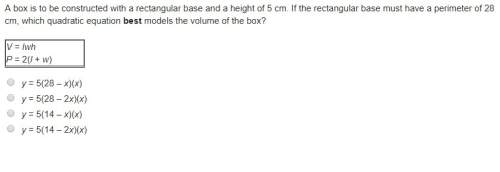
Mathematics, 04.10.2021 06:30, sanaiajohnson56
The horizontal position of an object in uniform motion is given by the formula d, = vt + d;. How many
seconds, t, does it take for an object moving at a velocity, v, of 88 ft/sec to move from an initial position,
d;, of - 128 ft to a final position, d, of 532 ft?

Answers: 1
Other questions on the subject: Mathematics

Mathematics, 21.06.2019 15:40, 1tallison1
What is the first quartile of this data set? 10, 11, 12, 15, 17, 19, 22, 24, 29, 33, 38 a. 12 b. 19 c. 29 d. 10
Answers: 1

Mathematics, 21.06.2019 18:30, 987654321156
The volume of gas a balloon can hold varies directly as the cube of its radius. imagine a balloon with a radius of 3 inches can hold 81 cubic inches of gas. how many cubic inches of gas must be released to reduce the radius down to 2 inches?
Answers: 1

Mathematics, 21.06.2019 22:00, lalanduni
Fatima plans to spend at least $15 and at most $20 dollars on sketch pads and pencils. if she buys 2 sketchpads, how many pemcils can she buy while staying in her price range? fatima can buy between and pencils. ? (type whole numbers. use ascending? order.)
Answers: 1

Do you know the correct answer?
The horizontal position of an object in uniform motion is given by the formula d, = vt + d;. How man...
Questions in other subjects:


Mathematics, 09.11.2020 19:00

Mathematics, 09.11.2020 19:00

Mathematics, 09.11.2020 19:00

English, 09.11.2020 19:00





Mathematics, 09.11.2020 19:00







